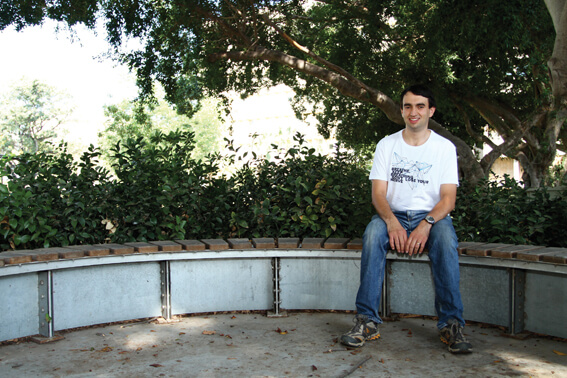Dr. Gurevich has been involved in mathematics for more than half of his life (he is 29 years old), and this is largely due to his studies at the legendary school number 30 in St. Petersburg, then Leningrad, which was known as an incubator for mathematical geniuses

Since childhood, Dmitry Gurevich knew that he would study exact sciences, but even when he was accepted to university at the age of 15, after immigrating to Israel from Russia, he was still not sure that he was interested in an academic career. The doubts disappeared only after he became familiar with representation theory, an extremely abstract area of mathematics. "I felt as if I had climbed to the top of a high mountain, and suddenly parts of the earth that I had not known existed until then were revealed to my eyes," recalled Dr. Gurevich, who recently joined the mathematics department at the Weizmann Institute of Science. "I experienced the immense joy of discovery. Suddenly I understood the connections that I did not know at all between different concepts".
Dr. Gurevich has been involved in mathematics for more than half of his life (he is 29 years old), and this is largely due to his studies at the legendary school number 30 in St. Petersburg, then Leningrad, which was known as a hotbed for mathematical geniuses: his students won an especially high number of prizes in city olympiads and nationalism, and many of them later became leading mathematicians.
After immigrating to Israel with his parents in 1995, Gurevich began studying mathematics at Tel Aviv University under the so-called "special status" arrangement, which allowed him to be admitted to the university at the same time as his high school studies. In Prof. Yosef Bernstein's course he was exposed to the magic of play theory. Later he chose this theory as the subject of his research, but before that he received a bachelor's degree with honors at the age of 18, completed his service in the IDF, and at the age of 22 was accepted as a research student at the Weizmann Institute of Science. After receiving his master's degree and his doctorate from the Weizmann Institute, both under the joint supervision of Prof. Bernstein from Tel Aviv University and Prof. Stephen Galbert from the Institute, Dr. Gurevich did post-doctoral research at the Institute for Advanced Studies in Princeton, and then at Rutgers University, New Jersey. He is now conducting research on the theory of plays as a senior researcher at the Weizmann Institute, a position he won in January of this year.
The strength of representation theory, which deals with the symmetries of linear spaces, stems from the combination of two basic concepts in mathematics: the linearization method and the concept of symmetry, which appears in many problems in mathematics, physics and other sciences. This theory has a wide variety of applications - in other fields of mathematics, quantum mechanics, engineering and computer science, but the implementation of basic research takes a long time. It took several decades until certain concepts of projection theory, which were developed in the late 19th and early 20th centuries, were applied to computed tomography, which is used for medical imaging. Decades passed until other concepts helped speed up calculations or provided solutions to important problems in computer science, such as the expander problem ("expanding graph"), the solution of which makes it possible to optimally connect many users to one communication network.
It is difficult to predict what applications may one day grow out of Dr. Gurevich's current research. Together with his colleagues, he already managed to prove the multiplicity one conjectures, which had not been solved for 20 years, and subsequently made several other contributions. One thing is certain: the peak of the mountain to which he climbs in his studies is particularly high - he works on representations of non-compact groups, known for their complexity. From this summit he hopes to discover new landscapes, currently hidden from most scientists.
A mathematical novel
Dimitri and his wife Anna met for the first time in a lecture on algebraic topology at Tel Aviv University. A shared interest in algebraic geometry contributed to their romance. Shortly after their wedding, the couple published a joint scientific article in the scientific journal Journal of Pure and Applied Algebra. Today they live with their children on the streets. Anna teaches mathematics at Tel Aviv University, from which she received her doctorate.

4 תגובות
Small correction:
"Applied in computed tomography, used for medical imaging"
An image, not an image.
It would be interesting to know what he thinks about mathematics itself. where did she come from
Truly inspiring. Well done.
Definitely inspiring. Rise up and be successful in everything you do - you are national pride